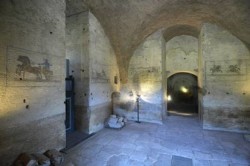Mausoleum of Valerius Romulus reopened to visitors after 20 years
 The massive tomb is located on Rome’s ancient Appian Way, standing within the remains of what was once a sports arena known as the Circus of Maxentius, itself part of a vast imperial complex built by Romulus’ father, the emperor Maxentius, in the early fourth century AD. Valerius Romulus (no relation to the Romulus who legend has it was the founder of Rome) died prematurely in 309. Mayor Ignazio Marino said the re-opening of the Mausoleum should be seen as part of the city’s ambitious plan to create what could be the world’s biggest archaeological park, stretching from the slopes of the Capitoline hill in central Rome all the way here to the Appia,. The restoration of the tomb was part of a broader facelift at the site costing a total of 873,000 euros.
The massive tomb is located on Rome’s ancient Appian Way, standing within the remains of what was once a sports arena known as the Circus of Maxentius, itself part of a vast imperial complex built by Romulus’ father, the emperor Maxentius, in the early fourth century AD. Valerius Romulus (no relation to the Romulus who legend has it was the founder of Rome) died prematurely in 309. Mayor Ignazio Marino said the re-opening of the Mausoleum should be seen as part of the city’s ambitious plan to create what could be the world’s biggest archaeological park, stretching from the slopes of the Capitoline hill in central Rome all the way here to the Appia,. The restoration of the tomb was part of a broader facelift at the site costing a total of 873,000 euros.
Excavations in the area were begun in 1825 by Italian archeologist Antonio Nibby. Much of the estate, located two to three miles out on the Appia Antica Appia, was however transformed into a working farm that continued to operate as such until it was expropriated in 1943. More excavations took place in the run-up to the 1960 Olympics and then during the 1970’s the raised median of the circus, called a “spina”, or spine, the 1000 feet (Roman feet, the equivalent of 296 meters) around which the chariots were raced, was uncovered. The Circus itself is the best preserved of all Roman circuses, and is second only in size to the Circus Maximus in Rome. However, it would appear that the only games held were the inaugural ones, probably at the time of Valerius’ death. In the centre stood the Obelisk of Domitian work to partially restore the mausoleum began at the beginning of the 80s. which in the 1600s was restored and erected in Piazza Navona by sculptor Gianlorenzo Bernini.
The complex was probably never used after the death of Maxentius in AD 312 (archaeological excavations indicate the tracks were covered in sand already in antiquity). The “carceres”, or starting gates, of the circus, the Palazzina Torlonia and the burial crypt are relatively recent additions to the work schedule and are still part of the work in progress today.


